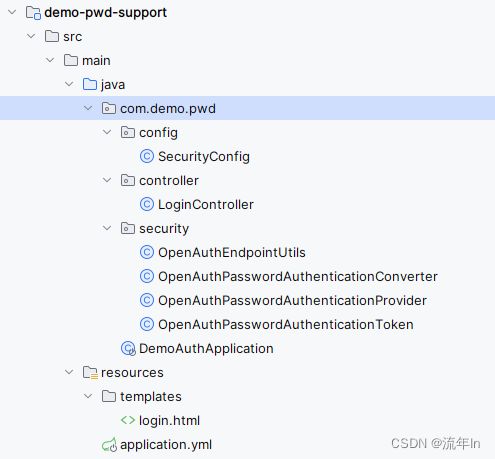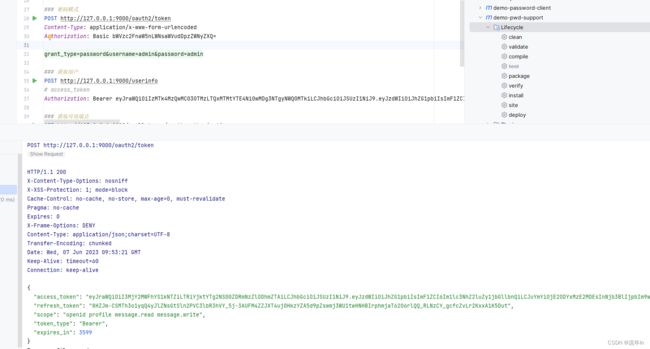Spring Authorization Server扩展实现OAuth2.0的密码模式
写在前面
Spring官方已经停止对Spring Security Oauth2的维护,项目和相关文档也被移除
Spring Authorization Server是官方新推出的OAuth2.1和OpenID Connect1.0的实现
两个主要的版本,0.4.x:jdk8。1.x: jdk17
这里用的版本是0.4.1
OAuth2.0已经不在推荐使用密码模式,OAuth2.1已经废除密码模式,这是为了安全考虑。
比如:我开发了一个网站,可以使用微信登录,我要求你提供用户名和密码,然后我拿到用户名和密码之后,去模拟你登录微信然后获取用户信息,也就是说我拿到了你的密码,然后我就能在你不知情的情况下做某些敏感操作,比如拉黑你的所有好友。当然:微信肯定有自己的验证,这些敏感的操作会被屏蔽。这里我只是举了一个例子。
通常且正确的模式是使用授权码模式。这里不多解释了,你可以简单理解为,在我这边登录,我返回token给你,然后你再用这个token去获取用户信息。当然,授权码模式复杂一点。
但是有个需求,第三方使用接入我平台的认证的时候,我允许提供用户名密码给第三方,然后第三方使用密码模式在我这边登录并拿到token,第三方拿到用户名密码后,允许第三方保存这个用户名和密码。这种方式是不是很扯,虽然不安全,但还是有这样的需求,需求大于一切。
Spring Security Oauth2里面没有密码模式的实现,所以我们需要自己写。
实现
- 添加依赖
<project xmlns="http://maven.apache.org/POM/4.0.0"
xmlns:xsi="http://www.w3.org/2001/XMLSchema-instance"
xsi:schemaLocation="http://maven.apache.org/POM/4.0.0 http://maven.apache.org/xsd/maven-4.0.0.xsd">
<modelVersion>4.0.0modelVersion>
<parent>
<groupId>com.demo.securitygroupId>
<artifactId>demo-securityartifactId>
<version>1.0.0-SNAPSHOTversion>
parent>
<artifactId>demo-pwd-supportartifactId>
<dependencies>
<dependency>
<groupId>org.springframework.bootgroupId>
<artifactId>spring-boot-starter-webartifactId>
dependency>
<dependency>
<groupId>org.springframework.bootgroupId>
<artifactId>spring-boot-starter-thymeleafartifactId>
dependency>
<dependency>
<groupId>org.springframework.securitygroupId>
<artifactId>spring-security-oauth2-authorization-serverartifactId>
dependency>
dependencies>
project>

这里重写了登录页面,是因为默认的登录页面会从国外加载某个资源(css),浏览器访问不了,所以很卡,这里就重写了一下登录页面,非常简单。
- OpenAuthEndpointUtils
import org.springframework.security.oauth2.core.AuthorizationGrantType;
import org.springframework.security.oauth2.core.OAuth2AuthenticationException;
import org.springframework.security.oauth2.core.OAuth2Error;
import org.springframework.security.oauth2.core.endpoint.OAuth2ParameterNames;
import org.springframework.security.oauth2.core.endpoint.PkceParameterNames;
import org.springframework.util.LinkedMultiValueMap;
import org.springframework.util.MultiValueMap;
import javax.servlet.http.HttpServletRequest;
import java.util.Map;
public class OpenAuthEndpointUtils {
static final String ACCESS_TOKEN_REQUEST_ERROR_URI = "https://datatracker.ietf.org/doc/html/rfc6749#section-5.2";
private OpenAuthEndpointUtils() {
}
public static MultiValueMap<String, String> getParameters(HttpServletRequest request) {
Map<String, String[]> parameterMap = request.getParameterMap();
MultiValueMap<String, String> parameters = new LinkedMultiValueMap<>(parameterMap.size());
parameterMap.forEach((key, values) -> {
for (String value : values) {
parameters.add(key, value);
}
});
return parameters;
}
public static boolean matchesPkceTokenRequest(HttpServletRequest request) {
return AuthorizationGrantType.AUTHORIZATION_CODE.getValue().equals(
request.getParameter(OAuth2ParameterNames.GRANT_TYPE)) &&
request.getParameter(OAuth2ParameterNames.CODE) != null &&
request.getParameter(PkceParameterNames.CODE_VERIFIER) != null;
}
public static void throwError(String errorCode, String parameterName, String errorUri) {
OAuth2Error error = new OAuth2Error(errorCode, "OAuth 2.0 Parameter: " + parameterName, errorUri);
throw new OAuth2AuthenticationException(error);
}
}
- OpenAuthPasswordAuthenticationConverter
import org.springframework.security.core.Authentication;
import org.springframework.security.core.context.SecurityContextHolder;
import org.springframework.security.oauth2.core.AuthorizationGrantType;
import org.springframework.security.oauth2.core.OAuth2ErrorCodes;
import org.springframework.security.oauth2.core.endpoint.OAuth2ParameterNames;
import org.springframework.security.web.authentication.AuthenticationConverter;
import org.springframework.util.MultiValueMap;
import org.springframework.util.StringUtils;
import javax.servlet.http.HttpServletRequest;
import java.util.Arrays;
import java.util.HashSet;
import java.util.Map;
import java.util.Set;
import java.util.stream.Collectors;
public class OpenAuthPasswordAuthenticationConverter implements AuthenticationConverter {
@Override
public Authentication convert(HttpServletRequest request) {
// grant_type (REQUIRED)
String grantType = request.getParameter(OAuth2ParameterNames.GRANT_TYPE);
if (!AuthorizationGrantType.PASSWORD.getValue().equals(grantType)) {
return null;
}
MultiValueMap<String, String> parameters = OpenAuthEndpointUtils.getParameters(request);
// scope (OPTIONAL)
String scope = parameters.getFirst(OAuth2ParameterNames.SCOPE);
if (StringUtils.hasText(scope) &&
parameters.get(OAuth2ParameterNames.SCOPE).size() != 1) {
OpenAuthEndpointUtils.throwError(
OAuth2ErrorCodes.INVALID_REQUEST,
OAuth2ParameterNames.SCOPE,
OpenAuthEndpointUtils.ACCESS_TOKEN_REQUEST_ERROR_URI);
}
Set<String> requestedScopes = null;
if (StringUtils.hasText(scope)) {
requestedScopes = new HashSet<>(
Arrays.asList(StringUtils.delimitedListToStringArray(scope, " ")));
}
// username (REQUIRED)
String username = parameters.getFirst(OAuth2ParameterNames.USERNAME);
if (!StringUtils.hasText(username) || parameters.get(OAuth2ParameterNames.USERNAME).size() != 1) {
OpenAuthEndpointUtils.throwError(
OAuth2ErrorCodes.INVALID_REQUEST,
OAuth2ParameterNames.USERNAME,
OpenAuthEndpointUtils.ACCESS_TOKEN_REQUEST_ERROR_URI);
}
// password (REQUIRED)
String password = parameters.getFirst(OAuth2ParameterNames.PASSWORD);
if (!StringUtils.hasText(password) || parameters.get(OAuth2ParameterNames.PASSWORD).size() != 1) {
OpenAuthEndpointUtils.throwError(
OAuth2ErrorCodes.INVALID_REQUEST,
OAuth2ParameterNames.PASSWORD,
OpenAuthEndpointUtils.ACCESS_TOKEN_REQUEST_ERROR_URI);
}
Authentication clientPrincipal = SecurityContextHolder.getContext().getAuthentication();
if (clientPrincipal == null) {
OpenAuthEndpointUtils.throwError(
OAuth2ErrorCodes.INVALID_REQUEST,
OAuth2ErrorCodes.INVALID_CLIENT,
OpenAuthEndpointUtils.ACCESS_TOKEN_REQUEST_ERROR_URI);
}
Map<String, Object> additionalParameters = parameters
.entrySet()
.stream()
.filter(e -> !e.getKey().equals(OAuth2ParameterNames.GRANT_TYPE) &&
!e.getKey().equals(OAuth2ParameterNames.SCOPE))
.collect(Collectors.toMap(Map.Entry::getKey, e -> e.getValue().get(0)));
return new OpenAuthPasswordAuthenticationToken(AuthorizationGrantType.PASSWORD, clientPrincipal, requestedScopes, additionalParameters);
}
}
- OpenAuthPasswordAuthenticationProvider
import org.apache.logging.log4j.LogManager;
import org.apache.logging.log4j.Logger;
import org.springframework.security.authentication.AuthenticationManager;
import org.springframework.security.authentication.AuthenticationProvider;
import org.springframework.security.authentication.UsernamePasswordAuthenticationToken;
import org.springframework.security.core.Authentication;
import org.springframework.security.core.AuthenticationException;
import org.springframework.security.oauth2.core.*;
import org.springframework.security.oauth2.core.endpoint.OAuth2ParameterNames;
import org.springframework.security.oauth2.core.oidc.OidcIdToken;
import org.springframework.security.oauth2.core.oidc.OidcScopes;
import org.springframework.security.oauth2.core.oidc.endpoint.OidcParameterNames;
import org.springframework.security.oauth2.jwt.Jwt;
import org.springframework.security.oauth2.server.authorization.OAuth2Authorization;
import org.springframework.security.oauth2.server.authorization.OAuth2AuthorizationService;
import org.springframework.security.oauth2.server.authorization.OAuth2TokenType;
import org.springframework.security.oauth2.server.authorization.authentication.OAuth2AccessTokenAuthenticationToken;
import org.springframework.security.oauth2.server.authorization.authentication.OAuth2ClientAuthenticationToken;
import org.springframework.security.oauth2.server.authorization.client.RegisteredClient;
import org.springframework.security.oauth2.server.authorization.context.AuthorizationServerContextHolder;
import org.springframework.security.oauth2.server.authorization.token.DefaultOAuth2TokenContext;
import org.springframework.security.oauth2.server.authorization.token.OAuth2TokenContext;
import org.springframework.security.oauth2.server.authorization.token.OAuth2TokenGenerator;
import org.springframework.util.Assert;
import org.springframework.util.CollectionUtils;
import java.security.Principal;
import java.util.*;
import java.util.stream.Collectors;
public class OpenAuthPasswordAuthenticationProvider implements AuthenticationProvider {
private static final Logger LOGGER = LogManager.getLogger();
private static final String ERROR_URI = "https://datatracker.ietf.org/doc/html/rfc6749#section-5.2";
private static final OAuth2TokenType ID_TOKEN_TOKEN_TYPE = new OAuth2TokenType(OidcParameterNames.ID_TOKEN);
private final AuthenticationManager authenticationManager;
private final OAuth2AuthorizationService authorizationService;
private final OAuth2TokenGenerator<? extends OAuth2Token> tokenGenerator;
/**
* Constructs an {@code OAuth2ResourceOwnerPasswordAuthenticationProviderNew} using the provided parameters.
*
* @param authenticationManager the authentication manager
* @param authorizationService the authorization service
* @param tokenGenerator the token generator
* @since 0.2.3
*/
public OpenAuthPasswordAuthenticationProvider(AuthenticationManager authenticationManager,
OAuth2AuthorizationService authorizationService, OAuth2TokenGenerator<? extends OAuth2Token> tokenGenerator) {
Assert.notNull(authorizationService, "authorizationService cannot be null");
Assert.notNull(tokenGenerator, "tokenGenerator cannot be null");
this.authenticationManager = authenticationManager;
this.authorizationService = authorizationService;
this.tokenGenerator = tokenGenerator;
}
@Override
public Authentication authenticate(Authentication authentication) throws AuthenticationException {
OpenAuthPasswordAuthenticationToken resouceOwnerPasswordAuthentication = (OpenAuthPasswordAuthenticationToken) authentication;
OAuth2ClientAuthenticationToken clientPrincipal = getAuthenticatedClientElseThrowInvalidClient(resouceOwnerPasswordAuthentication);
RegisteredClient registeredClient = clientPrincipal.getRegisteredClient();
if (LOGGER.isTraceEnabled()) {
LOGGER.trace("Retrieved registered client");
}
if (!registeredClient.getAuthorizationGrantTypes().contains(AuthorizationGrantType.PASSWORD)) {
throw new OAuth2AuthenticationException(OAuth2ErrorCodes.UNAUTHORIZED_CLIENT);
}
Authentication usernamePasswordAuthentication = getUsernamePasswordAuthentication(resouceOwnerPasswordAuthentication);
Set<String> authorizedScopes = registeredClient.getScopes(); // Default to configured scopes
Set<String> requestedScopes = resouceOwnerPasswordAuthentication.getScopes();
if (!CollectionUtils.isEmpty(requestedScopes)) {
Set<String> unauthorizedScopes = requestedScopes.stream()
.filter(requestedScope -> !registeredClient.getScopes().contains(requestedScope))
.collect(Collectors.toSet());
if (!CollectionUtils.isEmpty(unauthorizedScopes)) {
throw new OAuth2AuthenticationException(OAuth2ErrorCodes.INVALID_SCOPE);
}
authorizedScopes = new LinkedHashSet<>(requestedScopes);
}
if (LOGGER.isTraceEnabled()) {
LOGGER.trace("Validated token request parameters");
}
// @formatter:off
DefaultOAuth2TokenContext.Builder tokenContextBuilder = DefaultOAuth2TokenContext.builder()
.registeredClient(registeredClient)
.principal(usernamePasswordAuthentication)
.authorizationServerContext(AuthorizationServerContextHolder.getContext())
.authorizedScopes(authorizedScopes)
.authorizationGrantType(AuthorizationGrantType.PASSWORD)
.authorizationGrant(resouceOwnerPasswordAuthentication);
// @formatter:on
// ----- Access token -----
OAuth2TokenContext tokenContext = tokenContextBuilder.tokenType(OAuth2TokenType.ACCESS_TOKEN).build();
OAuth2Token generatedAccessToken = this.tokenGenerator.generate(tokenContext);
if (generatedAccessToken == null) {
OAuth2Error error = new OAuth2Error(OAuth2ErrorCodes.SERVER_ERROR,
"The token generator failed to generate the access token.", ERROR_URI);
throw new OAuth2AuthenticationException(error);
}
if (LOGGER.isTraceEnabled()) {
LOGGER.trace("Generated access token");
}
OAuth2AccessToken accessToken = new OAuth2AccessToken(OAuth2AccessToken.TokenType.BEARER,
generatedAccessToken.getTokenValue(), generatedAccessToken.getIssuedAt(),
generatedAccessToken.getExpiresAt(), tokenContext.getAuthorizedScopes());
// @formatter:off
OAuth2Authorization.Builder authorizationBuilder = OAuth2Authorization.withRegisteredClient(registeredClient)
.principalName(usernamePasswordAuthentication.getName())
.authorizationGrantType(AuthorizationGrantType.PASSWORD)
.authorizedScopes(authorizedScopes)
.attribute(Principal.class.getName(), usernamePasswordAuthentication);
// @formatter:on
if (generatedAccessToken instanceof ClaimAccessor) {
authorizationBuilder.token(accessToken, (metadata) ->
metadata.put(OAuth2Authorization.Token.CLAIMS_METADATA_NAME, ((ClaimAccessor) generatedAccessToken).getClaims()));
} else {
authorizationBuilder.accessToken(accessToken);
}
// ----- Refresh token -----
OAuth2RefreshToken refreshToken = null;
if (registeredClient.getAuthorizationGrantTypes().contains(AuthorizationGrantType.REFRESH_TOKEN) &&
// Do not issue refresh token to public client
!clientPrincipal.getClientAuthenticationMethod().equals(ClientAuthenticationMethod.NONE)) {
tokenContext = tokenContextBuilder.tokenType(OAuth2TokenType.REFRESH_TOKEN).build();
OAuth2Token generatedRefreshToken = this.tokenGenerator.generate(tokenContext);
if (!(generatedRefreshToken instanceof OAuth2RefreshToken)) {
OAuth2Error error = new OAuth2Error(OAuth2ErrorCodes.SERVER_ERROR,
"The token generator failed to generate the refresh token.", ERROR_URI);
throw new OAuth2AuthenticationException(error);
}
if (LOGGER.isTraceEnabled()) {
LOGGER.trace("Generated refresh token");
}
refreshToken = (OAuth2RefreshToken) generatedRefreshToken;
authorizationBuilder.refreshToken(refreshToken);
}
// ----- ID token -----
OidcIdToken idToken;
if (requestedScopes.contains(OidcScopes.OPENID)) {
// @formatter:off
tokenContext = tokenContextBuilder
.tokenType(ID_TOKEN_TOKEN_TYPE)
.authorization(authorizationBuilder.build()) // ID token customizer may need access to the access token and/or refresh token
.build();
// @formatter:on
OAuth2Token generatedIdToken = this.tokenGenerator.generate(tokenContext);
if (!(generatedIdToken instanceof Jwt)) {
OAuth2Error error = new OAuth2Error(OAuth2ErrorCodes.SERVER_ERROR,
"The token generator failed to generate the ID token.", ERROR_URI);
throw new OAuth2AuthenticationException(error);
}
if (LOGGER.isTraceEnabled()) {
LOGGER.trace("Generated id token");
}
idToken = new OidcIdToken(generatedIdToken.getTokenValue(), generatedIdToken.getIssuedAt(),
generatedIdToken.getExpiresAt(), ((Jwt) generatedIdToken).getClaims());
authorizationBuilder.token(idToken, (metadata) ->
metadata.put(OAuth2Authorization.Token.CLAIMS_METADATA_NAME, idToken.getClaims()));
} else {
idToken = null;
}
OAuth2Authorization authorization = authorizationBuilder.build();
this.authorizationService.save(authorization);
if (LOGGER.isTraceEnabled()) {
LOGGER.trace("Saved authorization");
}
Map<String, Object> additionalParameters = Collections.emptyMap();
if (idToken != null) {
additionalParameters = new HashMap<>();
additionalParameters.put(OidcParameterNames.ID_TOKEN, idToken.getTokenValue());
}
if (LOGGER.isTraceEnabled()) {
LOGGER.trace("Authenticated token request");
}
return new OAuth2AccessTokenAuthenticationToken(registeredClient, clientPrincipal, accessToken, refreshToken, additionalParameters);
}
@Override
public boolean supports(Class<?> authentication) {
boolean supports = OpenAuthPasswordAuthenticationToken.class.isAssignableFrom(authentication);
LOGGER.debug("supports authentication=" + authentication + " returning " + supports);
return supports;
}
private Authentication getUsernamePasswordAuthentication(OpenAuthPasswordAuthenticationToken resouceOwnerPasswordAuthentication) {
Map<String, Object> additionalParameters = resouceOwnerPasswordAuthentication.getAdditionalParameters();
String username = (String) additionalParameters.get(OAuth2ParameterNames.USERNAME);
String password = (String) additionalParameters.get(OAuth2ParameterNames.PASSWORD);
UsernamePasswordAuthenticationToken usernamePasswordAuthenticationToken = new UsernamePasswordAuthenticationToken(username, password);
LOGGER.debug("got usernamePasswordAuthenticationToken=" + usernamePasswordAuthenticationToken);
Authentication usernamePasswordAuthentication = authenticationManager.authenticate(usernamePasswordAuthenticationToken);
return usernamePasswordAuthentication;
}
private OAuth2ClientAuthenticationToken getAuthenticatedClientElseThrowInvalidClient(Authentication authentication) {
OAuth2ClientAuthenticationToken clientPrincipal = null;
if (OAuth2ClientAuthenticationToken.class.isAssignableFrom(authentication.getPrincipal().getClass())) {
clientPrincipal = (OAuth2ClientAuthenticationToken) authentication.getPrincipal();
}
if (clientPrincipal != null && clientPrincipal.isAuthenticated()) {
return clientPrincipal;
}
throw new OAuth2AuthenticationException(OAuth2ErrorCodes.INVALID_CLIENT);
}
}
- OpenAuthPasswordAuthenticationToken
import org.springframework.lang.Nullable;
import org.springframework.security.authentication.AbstractAuthenticationToken;
import org.springframework.security.core.Authentication;
import org.springframework.security.oauth2.core.AuthorizationGrantType;
import org.springframework.util.Assert;
import java.util.*;
public class OpenAuthPasswordAuthenticationToken extends AbstractAuthenticationToken {
private static final long serialVersionUID = -6067207202119450764L;
private final AuthorizationGrantType authorizationGrantType;
private final Authentication clientPrincipal;
private final Set<String> scopes;
private final Map<String, Object> additionalParameters;
/**
* Constructs an {@code OAuth2ClientCredentialsAuthenticationToken} using the provided parameters.
*
* @param clientPrincipal the authenticated client principal
*/
public OpenAuthPasswordAuthenticationToken(AuthorizationGrantType authorizationGrantType,
Authentication clientPrincipal, @Nullable Set<String> scopes, @Nullable Map<String, Object> additionalParameters) {
super(Collections.emptyList());
Assert.notNull(authorizationGrantType, "authorizationGrantType cannot be null");
Assert.notNull(clientPrincipal, "clientPrincipal cannot be null");
this.authorizationGrantType = authorizationGrantType;
this.clientPrincipal = clientPrincipal;
this.scopes = Collections.unmodifiableSet(scopes != null ? new HashSet<>(scopes) : Collections.emptySet());
this.additionalParameters = Collections.unmodifiableMap(additionalParameters != null ? new HashMap<>(additionalParameters) : Collections.emptyMap());
}
/**
* Returns the authorization grant type.
*
* @return the authorization grant type
*/
public AuthorizationGrantType getGrantType() {
return this.authorizationGrantType;
}
@Override
public Object getPrincipal() {
return this.clientPrincipal;
}
@Override
public Object getCredentials() {
return "";
}
/**
* Returns the requested scope(s).
*
* @return the requested scope(s), or an empty {@code Set} if not available
*/
public Set<String> getScopes() {
return this.scopes;
}
/**
* Returns the additional parameters.
*
* @return the additional parameters
*/
public Map<String, Object> getAdditionalParameters() {
return this.additionalParameters;
}
}
- SecurityConfig
import com.demo.pwd.security.OpenAuthPasswordAuthenticationConverter;
import com.demo.pwd.security.OpenAuthPasswordAuthenticationProvider;
import com.nimbusds.jose.jwk.JWKSet;
import com.nimbusds.jose.jwk.RSAKey;
import com.nimbusds.jose.jwk.source.ImmutableJWKSet;
import com.nimbusds.jose.jwk.source.JWKSource;
import com.nimbusds.jose.proc.SecurityContext;
import org.springframework.context.annotation.Bean;
import org.springframework.context.annotation.Configuration;
import org.springframework.core.annotation.Order;
import org.springframework.security.authentication.AuthenticationManager;
import org.springframework.security.config.Customizer;
import org.springframework.security.config.annotation.web.builders.HttpSecurity;
import org.springframework.security.config.annotation.web.configuration.EnableWebSecurity;
import org.springframework.security.config.annotation.web.configurers.oauth2.server.resource.OAuth2ResourceServerConfigurer;
import org.springframework.security.core.userdetails.User;
import org.springframework.security.core.userdetails.UserDetails;
import org.springframework.security.core.userdetails.UserDetailsService;
import org.springframework.security.oauth2.core.AuthorizationGrantType;
import org.springframework.security.oauth2.core.ClientAuthenticationMethod;
import org.springframework.security.oauth2.core.OAuth2Token;
import org.springframework.security.oauth2.core.oidc.OidcScopes;
import org.springframework.security.oauth2.jwt.JwtDecoder;
import org.springframework.security.oauth2.server.authorization.OAuth2AuthorizationService;
import org.springframework.security.oauth2.server.authorization.client.InMemoryRegisteredClientRepository;
import org.springframework.security.oauth2.server.authorization.client.RegisteredClient;
import org.springframework.security.oauth2.server.authorization.client.RegisteredClientRepository;
import org.springframework.security.oauth2.server.authorization.config.annotation.web.configuration.OAuth2AuthorizationServerConfiguration;
import org.springframework.security.oauth2.server.authorization.config.annotation.web.configurers.OAuth2AuthorizationServerConfigurer;
import org.springframework.security.oauth2.server.authorization.settings.AuthorizationServerSettings;
import org.springframework.security.oauth2.server.authorization.settings.TokenSettings;
import org.springframework.security.oauth2.server.authorization.token.OAuth2TokenGenerator;
import org.springframework.security.oauth2.server.authorization.web.authentication.DelegatingAuthenticationConverter;
import org.springframework.security.oauth2.server.authorization.web.authentication.OAuth2AuthorizationCodeAuthenticationConverter;
import org.springframework.security.oauth2.server.authorization.web.authentication.OAuth2ClientCredentialsAuthenticationConverter;
import org.springframework.security.oauth2.server.authorization.web.authentication.OAuth2RefreshTokenAuthenticationConverter;
import org.springframework.security.provisioning.InMemoryUserDetailsManager;
import org.springframework.security.web.DefaultSecurityFilterChain;
import org.springframework.security.web.SecurityFilterChain;
import org.springframework.security.web.authentication.LoginUrlAuthenticationEntryPoint;
import java.security.KeyPair;
import java.security.KeyPairGenerator;
import java.security.interfaces.RSAPrivateKey;
import java.security.interfaces.RSAPublicKey;
import java.time.Duration;
import java.util.Arrays;
import java.util.UUID;
/**
* TODO description
*
* @author qiudw
* @date 6/7/2023
*/
@Configuration
@EnableWebSecurity(debug = true)
public class SecurityConfig {
private static KeyPair generateRsaKey() {
KeyPair keyPair;
try {
KeyPairGenerator keyPairGenerator = KeyPairGenerator.getInstance("RSA");
keyPairGenerator.initialize(2048);
keyPair = keyPairGenerator.generateKeyPair();
} catch (Exception ex) {
throw new IllegalStateException(ex);
}
return keyPair;
}
@Bean
@Order(1)
public SecurityFilterChain authorizationServerSecurityFilterChain(HttpSecurity http)
throws Exception {
// 默认配置
OAuth2AuthorizationServerConfiguration.applyDefaultSecurity(http);
OAuth2AuthorizationServerConfigurer authorizationServerConfigurer = new OAuth2AuthorizationServerConfigurer();
http.apply(authorizationServerConfigurer)
// Enable OpenID Connect 1.0
.oidc(Customizer.withDefaults())
// 在这加上密码模式的转换器
.tokenEndpoint(tokenEndpoint -> tokenEndpoint.accessTokenRequestConverter(
new DelegatingAuthenticationConverter(Arrays.asList(
new OAuth2AuthorizationCodeAuthenticationConverter(),
new OAuth2RefreshTokenAuthenticationConverter(),
new OAuth2ClientCredentialsAuthenticationConverter(),
new OpenAuthPasswordAuthenticationConverter()
))
));
http
// Redirect to the login page when not authenticated from the
// authorization endpoint
.exceptionHandling((exceptions) -> exceptions
.authenticationEntryPoint(new LoginUrlAuthenticationEntryPoint("/login")))
// Accept access tokens for User Info and/or Client Registration
.oauth2ResourceServer(OAuth2ResourceServerConfigurer::jwt);
// 先build
DefaultSecurityFilterChain securityFilterChain = http
.requestMatcher(authorizationServerConfigurer.getEndpointsMatcher())
// 这个必须禁用
.csrf().disable()
.build();
// 密码模式的认证提供者
addPasswordAuthenticationProvider(http);
return securityFilterChain;
}
@Bean
@Order(2)
public SecurityFilterChain defaultSecurityFilterChain(HttpSecurity http)
throws Exception {
http
.authorizeHttpRequests()
.antMatchers("/assets/**", "/webjars/**", "/login", "/favicon.ico").permitAll()
.anyRequest().authenticated()
.and()
// Form login handles the redirect to the login page from the
// authorization server filter chain
.formLogin()
.loginPage("/login")
.loginProcessingUrl("/login");
// // 资源服务器
// http.oauth2ResourceServer(OAuth2ResourceServerConfigurer::jwt);
return http.build();
}
@Bean
public UserDetailsService userDetailsService() {
UserDetails userDetails = User.builder()
.username("admin")
.password("{noop}admin")
.roles("ADMIN")
.build();
return new InMemoryUserDetailsManager(userDetails);
}
@Bean
public RegisteredClientRepository registeredClientRepository() {
RegisteredClient registeredClient = RegisteredClient.withId(UUID.randomUUID().toString())
.clientId("messaging-client")
.clientSecret("{noop}secret")
.clientAuthenticationMethod(ClientAuthenticationMethod.CLIENT_SECRET_BASIC)
.authorizationGrantType(AuthorizationGrantType.AUTHORIZATION_CODE)
.authorizationGrantType(AuthorizationGrantType.REFRESH_TOKEN)
.authorizationGrantType(AuthorizationGrantType.CLIENT_CREDENTIALS)
// 密码模式
.authorizationGrantType(AuthorizationGrantType.PASSWORD)
.redirectUri("http://127.0.0.1:8080/login/oauth2/code/messaging-client-oidc")
.redirectUri("http://127.0.0.1:8080/authorized")
.redirectUri("https://baidu.com")
.scope(OidcScopes.OPENID)
.scope(OidcScopes.PROFILE)
.scope("message.read")
.scope("message.write")
.tokenSettings(TokenSettings.builder().accessTokenTimeToLive(Duration.ofHours(1L)).build())
// .clientSettings(ClientSettings.builder().requireAuthorizationConsent(true).build())
.build();
return new InMemoryRegisteredClientRepository(registeredClient);
}
@Bean
public JWKSource<SecurityContext> jwkSource() {
KeyPair keyPair = generateRsaKey();
RSAPublicKey publicKey = (RSAPublicKey) keyPair.getPublic();
RSAPrivateKey privateKey = (RSAPrivateKey) keyPair.getPrivate();
RSAKey rsaKey = new RSAKey.Builder(publicKey)
.privateKey(privateKey)
.keyID(UUID.randomUUID().toString())
.build();
JWKSet jwkSet = new JWKSet(rsaKey);
return new ImmutableJWKSet<>(jwkSet);
}
@Bean
public JwtDecoder jwtDecoder(JWKSource<SecurityContext> jwkSource) {
return OAuth2AuthorizationServerConfiguration.jwtDecoder(jwkSource);
}
@Bean
public AuthorizationServerSettings authorizationServerSettings() {
return AuthorizationServerSettings.builder().build();
}
@SuppressWarnings("unchecked")
private void addPasswordAuthenticationProvider(HttpSecurity http) {
AuthenticationManager authenticationManager = http.getSharedObject(AuthenticationManager.class);
OAuth2AuthorizationService authorizationService = http.getSharedObject(OAuth2AuthorizationService.class);
OAuth2TokenGenerator<? extends OAuth2Token> tokenGenerator = http.getSharedObject(OAuth2TokenGenerator.class);
OpenAuthPasswordAuthenticationProvider resourceOwnerPasswordAuthenticationProvider =
new OpenAuthPasswordAuthenticationProvider(authenticationManager, authorizationService, tokenGenerator);
// This will add new authentication provider in the list of existing authentication providers.
http.authenticationProvider(resourceOwnerPasswordAuthenticationProvider);
}
}
- DemoAuthApplication
import org.springframework.boot.SpringApplication;
import org.springframework.boot.autoconfigure.SpringBootApplication;
/**
*
* @author qiudw
* @date 6/7/2023
*/
@SpringBootApplication
public class DemoAuthApplication {
public static void main(String[] args) {
SpringApplication.run(DemoAuthApplication.class, args);
}
}
- LoginController
import org.springframework.stereotype.Controller;
import org.springframework.web.bind.annotation.GetMapping;
/**
* 登录相关
*
* @author qiudw
* @date 5/17/2023
*/
@Controller
public class LoginController {
/**
* 登录页面
*
* @return 登录页面路径
*/
@GetMapping("/login")
public String login() {
return "login";
}
}
- login.html
DOCTYPE html>
<html lang="en">
<head>
<meta charset="UTF-8">
<title>Logintitle>
head>
<body>
<form th:action="@{/login}" method="post">
<input type="text" name="username" placeholder="用户名" /> <br/>
<input type="password" name="password" placeholder="密码" /> <br/>
<button type="submit">登录button> <br/>
form>
body>
html>
- application.yml
server:
port: 9000
测试案例
授权码模式的时候重定向地址是百度
### 授权码模式:浏览器 - 获取授权码
http://127.0.0.1:9000/oauth2/authorize?response_type=code&client_id=messaging-client&redirect_uri=https://baidu.com&scope=message.read message.write openid
### 授权码模式:使用授权码换取token
POST http://127.0.0.1:9000/oauth2/token
Content-Type: application/x-www-form-urlencoded
# 这个是base64(${clientId}:${clientSecret})
Authorization: Basic bWVzc2FnaW5nLWNsaWVudDpzZWNyZXQ=
grant_type=authorization_code&redirect_uri=https://baidu.com&code=WQfVvh3eP1tTifBHiKgZd5iifsVhA4t5QSPOv8YAWFRur-X5hiMXL7rY54LFGR0oXs1SWcycnt-8kxPquVnYCA-e3RYcfdg7Rq_q0M3K0Gws7Er1N1dC2lnJRKRUKpO3
### 刷新token
POST http://127.0.0.1:9000/oauth2/token
Content-Type: application/x-www-form-urlencoded
# 这个是base64(${clientId}:${clientSecret})
Authorization: Basic bWVzc2FnaW5nLWNsaWVudDpzZWNyZXQ=
grant_type=refresh_token&refresh_token=7q5syxjItfPD-w63zo7mjIRCHhvo15fz5xybmYQJe9unXOXn12MjhgH0Ckrkysut3eq1SyaJYxm6l-SLeSFjoS-8kHrovGEUH54pb8UE_TbgR0BPhvV01-1CngQeGNwv
### 客户端模式
POST http://127.0.0.1:9000/oauth2/token
Content-Type: application/x-www-form-urlencoded
Authorization: Basic bWVzc2FnaW5nLWNsaWVudDpzZWNyZXQ=
grant_type=client_credentials
### 密码模式
POST http://127.0.0.1:9000/oauth2/token
Content-Type: application/x-www-form-urlencoded
Authorization: Basic bWVzc2FnaW5nLWNsaWVudDpzZWNyZXQ=
grant_type=password&username=admin&password=admin
### 获取用户
POST http://127.0.0.1:9000/userinfo
# access_token
Authorization: Bearer eyJraWQiOiIzMTk4MzQwMC03OTMzLTQxMTMtYTE4Ni0wMDg3NTgyNWQ0MTkiLCJhbGciOiJSUzI1NiJ9.eyJzdWIiOiJhZG1pbiIsImF1ZCI6Im1lc3NhZ2luZy1jbGllbnQiLCJuYmYiOjE2ODYxMjk5NDIsInNjb3BlIjpbIm9wZW5pZCIsIm1lc3NhZ2UucmVhZCIsIm1lc3NhZ2Uud3JpdGUiXSwiaXNzIjoiaHR0cDovLzEyNy4wLjAuMTo5MDAwIiwiZXhwIjoxNjg2MTMzNTQyLCJpYXQiOjE2ODYxMjk5NDJ9.a_ya4kRqOx3iCn27QdxpCg0h8etgYGcPqDjVFWbzmieQ1oUHZuVCsxcJcioewp9tmRQ-NwVL86mQBWNwLxQ555fhqTAAjzFg1-obKFS_RoulOIyNkTMgjL7oUV_p-_L7BQLLqvE_E57-8V_dvsZn7xQavY4TbwHH2QNWVCDKS807CmdOJErE7idsEZZbiyHtB0JcGn7VAfBHCpVyADN8HzgZVEtfuOtrgBGTOpypNJwb0kADgd7661l4P2hBSaInUI-m0m-I1-E-Q47lM0WAUtwHUusavxsd7ADEYNSAHgc3-s8ME4yqvRwrPIfuhWejYPm4WVoC04c5dvcnAIlDDg
### 获取可用端点
GET http://127.0.0.1:9000/.well-known/oauth-authorization-server
### 获取可用端点
GET http://127.0.0.1:9000/.well-known/openid-configuration
### 吊销令牌
POST http://127.0.0.1:9000/oauth2/revoke
Content-Type: application/x-www-form-urlencoded
Authorization: Basic bWVzc2FnaW5nLWNsaWVudDpzZWNyZXQ=
#token_type_hint=refresh_token&token=klA-i51s2hVbankpkg9kRh9jk1EIFJnwHhdAYHbS7LoW9YBwMRvqSShOL_8h_LgunSytWh-08JveyLedHfAUD8ovrTjled6i7HYIgwKQUSP18zUTCThs-HV8AeboTtfX
token_type_hint=access_token&token=eyJraWQiOiIzMTk4MzQwMC03OTMzLTQxMTMtYTE4Ni0wMDg3NTgyNWQ0MTkiLCJhbGciOiJSUzI1NiJ9.eyJzdWIiOiJhZG1pbiIsImF1ZCI6Im1lc3NhZ2luZy1jbGllbnQiLCJuYmYiOjE2ODYxMjk5NjEsInNjb3BlIjpbIm9wZW5pZCIsInByb2ZpbGUiLCJtZXNzYWdlLnJlYWQiLCJtZXNzYWdlLndyaXRlIl0sImlzcyI6Imh0dHA6Ly8xMjcuMC4wLjE6OTAwMCIsImV4cCI6MTY4NjEzMzU2MSwiaWF0IjoxNjg2MTI5OTYxfQ.k66ovHpVKiEqRWlotffiDPdrcni8ltuhLkhI8Evg6WZd4xc7GzqIAtL5qqAXsW0o4FjSaqTSKkrkjcAzcPx3dgatCjhHrY7_FleywRBHrvpY0rH5MJMWsoQourdBa0SIO5WwlOZwiC_OVArF5rzTZldG-e0Skpbh8PppzfIMWQ1usSyGMxlJMKXkVOjumCKJu_JWrj3gAzTPfSbJS5ikPx0G6t5GXvKnBKQXKWr-umabharF5IZQ2jEctlIAllm_EoAA1YtzfbQPRkATjXY0mYJboemaF0FsDoOQDpbA5VU6pPuM6sxfv64D1wNcFR0HO6vuWYRR9k3XqIUjGgL_Ig
拿到这里access_token,可以解析出来看看https://tool.box3.cn/jwt.html

客户端模式获取的access_token,这个认证主体是客户端id




